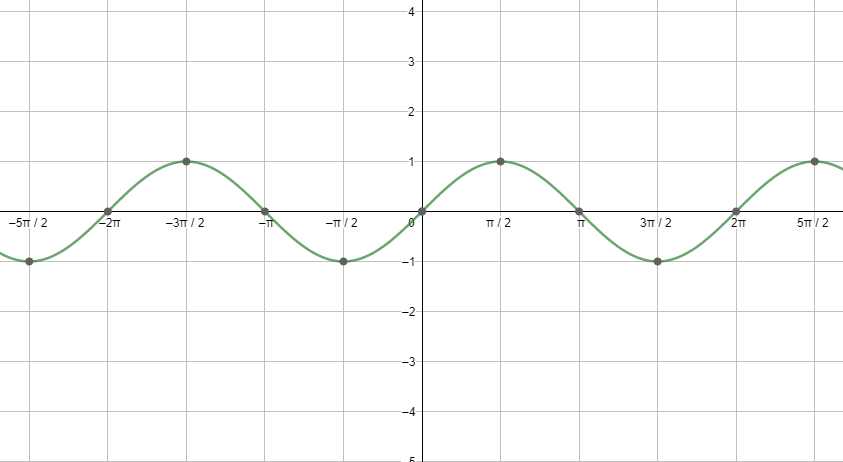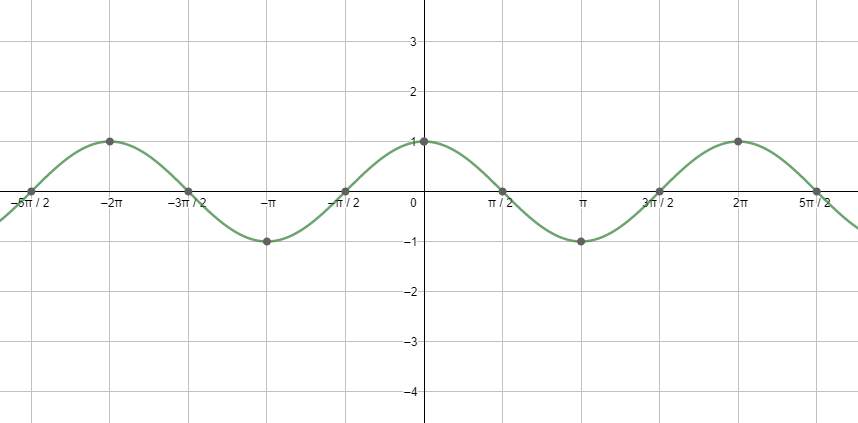
Prove that $\cos \left( 36{}^\circ -A \right)\cos \left( 36{}^\circ +A \right)+\cos \left( 54{}^\circ +A \right)\cos \left( 54{}^\circ -A \right)=\cos 2A$ .
Answer
591k+ views
Hint: Try to simplify the left-hand side of the equation that we need to prove by using the property that $\cos \left( 90{}^\circ -\alpha \right)=\sin \alpha $ , $\cos \left( 90{}^\circ +\alpha \right)=-\sin \alpha $ , and other similar formulas. You will also need the formula $\cos A\cos B+\sin A\sin B=\cos \left( A-B \right)$ .
Complete step-by-step answer:
Before moving to the solution, let us discuss the periodicity of sine and cosine function, which we would be using in the solution. All the trigonometric ratios, including sine and cosine, are periodic functions. We can better understand this using the graph of sine and cosine.
First, let us start with the graph of sinx.

Next, let us see the graph of cosx.

Looking at both the graphs, we can say that the graphs are repeating after a fixed period i.e. $2{{\pi }^{c}}$ . So, we can say that the fundamental period of the cosine function and the sine function is $2{{\pi }^{c}}=360{}^\circ $
We will now solve the left-hand side of the equation given in the question.
$\cos \left( 36{}^\circ -A \right)\cos \left( 36{}^\circ +A \right)+\cos \left( 54{}^\circ +A \right)\cos \left( 54{}^\circ -A \right)$
Now we know $\sin \left( 90{}^\circ -x \right)=\cos x$ . On putting these values in our expression, we get
$\cos \left( 36{}^\circ -A \right)\cos \left( 36{}^\circ +A \right)+\sin \left( 90{}^\circ -\left( 54{}^\circ +A \right) \right)\sin \left( 90{}^\circ -\left( 54{}^\circ -A \right) \right)$
$=\cos \left( 36{}^\circ -A \right)\cos \left( 36{}^\circ +A \right)+\sin \left( 36{}^\circ -A \right)\sin \left( 36{}^\circ +A \right)$
Now we know $\cos A\cos B+\sin A\sin B=\cos \left( A-B \right)$ . Therefore, our expression becomes:
$\cos \left( 36{}^\circ +A-\left( 36{}^\circ -A \right) \right)$
$=\cos 2A$
As we have shown that left-hand side of the equation given in the question is equal to right-hand side of the equation in the question we can say that we have proved that $\cos \left( 36{}^\circ -A \right)\cos \left( 36{}^\circ +A \right)+\cos \left( 54{}^\circ +A \right)\cos \left( 54{}^\circ -A \right)=\cos 2A$ .
Note: Be careful about the sign in the formula of cos(A-B). Also, be careful about the signs while opening the brackets, as the general mistake that a student can make is 1+x-(x-1)=1+x-x-1. Also, you need to remember the properties related to complementary angles and trigonometric ratios. Whenever you come across a question where you see the trigonometric ratios of non-standard angles, always try to eliminate the non-standard angles using trigonometric identities, as we did in the above question.
Complete step-by-step answer:
Before moving to the solution, let us discuss the periodicity of sine and cosine function, which we would be using in the solution. All the trigonometric ratios, including sine and cosine, are periodic functions. We can better understand this using the graph of sine and cosine.
First, let us start with the graph of sinx.

Next, let us see the graph of cosx.

Looking at both the graphs, we can say that the graphs are repeating after a fixed period i.e. $2{{\pi }^{c}}$ . So, we can say that the fundamental period of the cosine function and the sine function is $2{{\pi }^{c}}=360{}^\circ $
We will now solve the left-hand side of the equation given in the question.
$\cos \left( 36{}^\circ -A \right)\cos \left( 36{}^\circ +A \right)+\cos \left( 54{}^\circ +A \right)\cos \left( 54{}^\circ -A \right)$
Now we know $\sin \left( 90{}^\circ -x \right)=\cos x$ . On putting these values in our expression, we get
$\cos \left( 36{}^\circ -A \right)\cos \left( 36{}^\circ +A \right)+\sin \left( 90{}^\circ -\left( 54{}^\circ +A \right) \right)\sin \left( 90{}^\circ -\left( 54{}^\circ -A \right) \right)$
$=\cos \left( 36{}^\circ -A \right)\cos \left( 36{}^\circ +A \right)+\sin \left( 36{}^\circ -A \right)\sin \left( 36{}^\circ +A \right)$
Now we know $\cos A\cos B+\sin A\sin B=\cos \left( A-B \right)$ . Therefore, our expression becomes:
$\cos \left( 36{}^\circ +A-\left( 36{}^\circ -A \right) \right)$
$=\cos 2A$
As we have shown that left-hand side of the equation given in the question is equal to right-hand side of the equation in the question we can say that we have proved that $\cos \left( 36{}^\circ -A \right)\cos \left( 36{}^\circ +A \right)+\cos \left( 54{}^\circ +A \right)\cos \left( 54{}^\circ -A \right)=\cos 2A$ .
Note: Be careful about the sign in the formula of cos(A-B). Also, be careful about the signs while opening the brackets, as the general mistake that a student can make is 1+x-(x-1)=1+x-x-1. Also, you need to remember the properties related to complementary angles and trigonometric ratios. Whenever you come across a question where you see the trigonometric ratios of non-standard angles, always try to eliminate the non-standard angles using trigonometric identities, as we did in the above question.
Recently Updated Pages
Master Class 10 General Knowledge: Engaging Questions & Answers for Success

Master Class 10 Science: Engaging Questions & Answers for Success

Master Class 10 Social Science: Engaging Questions & Answers for Success

Master Class 10 Maths: Engaging Questions & Answers for Success

Master Class 10 English: Engaging Questions & Answers for Success

Master Class 10 Computer Science: Engaging Questions & Answers for Success

Trending doubts
Why is there a time difference of about 5 hours between class 10 social science CBSE

Write a letter to the principal requesting him to grant class 10 english CBSE

What is the median of the first 10 natural numbers class 10 maths CBSE

The Equation xxx + 2 is Satisfied when x is Equal to Class 10 Maths

Which of the following does not have a fundamental class 10 physics CBSE

State and prove converse of BPT Basic Proportionality class 10 maths CBSE




